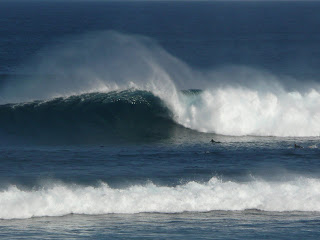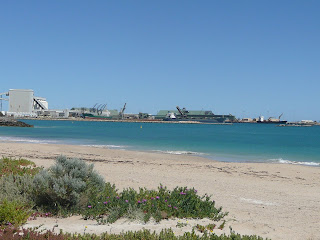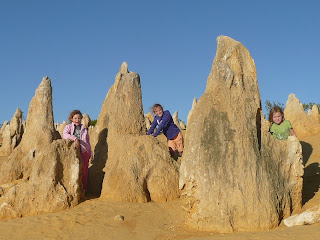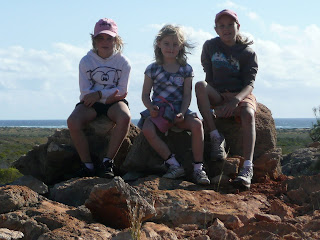










If you drop a plumb-line down from Perth, the little corner of the state that would be west of the line is the south-west region - or Margaret River region. It has two little capes (pointy bits that stick out) - one at the top and one at the bottom, with a lighthouse on each. It also has about 150 wineries, which is ridiculous when it has only around 5,500 hectares under vine (compared with over 7,000ha in McLaren Vale or Barossa). Each of them seems to have a cellar door as well, and a restaurant or cafe, or maybe a maze or other "attraction". Luckily for them, tourism is faring better than the wine industry, and they probably sell most of what they make through the cellar door, but the amount of capital expenditure seems out of proportion.
Another thing the region has plenty of is surf breaks - at least 30 down the 100km or so of west coast. We thought about sampling them all in the way that some people might sample the wineries, but it wasn't really practical! We were staying at Yallingup - at the base of the northern cape on the west coast - and it had probably the best surf beach anyway. Yallingup is an Aboriginal word for "place of love" and we certainly thought it was pretty special. We were staying in a caravan park right across the road from the beach; near enough to hear the surf roar at night and for Andrew to walk barefoot across to the beach with his board. It was unpretentious, quiet, green and very scenic. It would have been perfect for a quiet few days relaxing by the beach.......... but that's not our style! We packed plenty into our three days, including climbing both lighthouses, exploring two caves (another thing the region has plenty of), snorkelling (in a sheltered lagoon inside the reef on the beach right in front of the caravan park) and (the highlight for the girls) visiting a working sheep farm and shearing shed. This was a great experience, as we were given a shearing demonstration but also shown what the rouseabout does (Kendall as a "volunteer" trying to sweep the floor with a "witch's broom" was very funny for the rest of us) and how baling used to be done by stomping on the wool (Kirralee loved doing this). Then there was bottle-feeding the lambs, watching the dogs round up the sheep into the pens, and feeding the sheep outside in the paddock............ I learned that you have to have a second type of dog to run over the backs of the sheep from the back of the flock to the front, because otherwise the front sheep won't move (if it can't see the dog then it isn't scared and doesn't move). You can't use a border collie because they don't run over the sheep - they only chase them.
The caves were very interesting, too - and we can all now identify the different features: shawls, straws and helictites as well as your basic stalactites and stalagmites. It was a nice contrast going from the "lows" of the caves to the "highs" of the lighthouses............. They were quite different from each other, too, showing how the characteristics of the site determine how the lighthouse will be constructed. Both had relied on three lighthouse keepers to work four-hour shifts for 24 hours a day, winding the mechanism and carting the kerosene up the stairs, until electric motors were introduced in the 1960s. Now they are deserted apart from the tourists, operating completely automatically, but still performing exactly the same function they have performed since they were built over 100 years ago. The Cape Leeuwin Lighthouse, at the bottom of the region south of Augusta, looks out over the point where the Indian Ocean meets the Southern Ocean - and you can see a small group of rocks where the waves come in and break over them from different directions (well - supposedly!). We preferred the Cape Naturaliste lighthouse, which was smaller (because it is on a big hill) but the tour guide was much more informative, the scenery was better, and there was a walking trail down to a clifftop where we saw lots of seals playing. It's a great spot for whale-spotting, too, because the whales apparently come in very close to the cape and then follow an invisible "turn left" sign and head down the coast to the southern ocean - but we didn't see any!
We went into Margaret River, but we weren't very impressed. Too "touristy" and quite pretentious with it. The number of "health spas", "boutique shops", "unique art galleries" and "trendy cafes" in the brochures was definitely excessive! We found a shell museum, though, in someone's house out of town and that was quite simply mind-blowing. The number and variety of shells was quite astounding. I am becoming a bit of a shell "tragic", I think. I can't believe how they are all simply the protective casings of very simple creatures called (unromantically) "molluscs" who have barely 10 different body parts and no brain to speak of. (Oops - I digress.) Anyway, the shell museum was MUCH better than the "Chocolate Factory" - which was just a shop with a window into the kitchen, selling huge amounts of overpriced chocolates and designer coffees to busloads of tourists.
Oh yes - and we did visit one lovely cellar door in Yallingup, where we stocked up on Sauvignon Blanc and Andrew was introduced to the delights of Muscat.
The Cape Leeuwin Lighthouse was a stop on our way out of the region, on the day when we had to turn east for the first time, and start heading for home along the southern coast. A sobering thought!
Captions for pictures
- Yallingup Beach special
- Kendall didn't enjoy being a rouseabout..............
........nearly as much as Kirralee enjoyed being a baler
- Beautiful flower on big trees in Caves Hotel gardens at Yallingup
- Typical surf at Yallingup: six to eight foot clean and off-shore
- Kirralee in a "tunnel" within Ngilgi Cave
- Lovely "shawl" formation in Ngilgi Cave
- Cape Naturaliste lighthouse built in 1903 (internal structure sent over from the UK!)
- Tahlia holding the $500, 1000 watt lightglobe for the lighthouse VERY carefully
- The Cape Leeuwin lighthouse - tallest on mainland Australia (also made in England)
- Where the Indian Ocean meets the Southern Ocean....... and so do we!










































